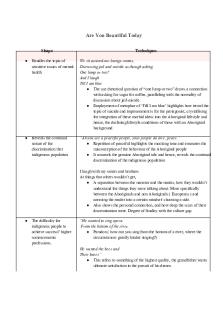2.b.9 Job Enrichment Practices Today PDF

| Title | 2.b.9 Job Enrichment Practices Today |
|---|---|
| Author | Cloy Newin |
| Course | Behaviour in Organizations |
| Institution | Douglas College |
| Pages | 2 |
| File Size | 44.4 KB |
| File Type | |
| Total Downloads | 112 |
| Total Views | 153 |
Summary
Graham Rodwell...
Description
2.b.9. Job Enrichment Practices Today The previous texts suggested that the Job Characteristics Model, when combined with social factors, is quite successful in predicting work related attitudes and some outcomes, such as subjective performance and intention to quit, even though the correlations with other behaviours and objective performance appeared much lower. However, Hackman and Oldham (1975) did not develop their framework with the main aim of making research predictions. They followed Herzberg (1968) in wanting to promote change in management practices and the organization of work. They wanted organizations to introduce ‘job enrichment’ practices that would improve job characteristics. There have been many prescriptive theories over the last 50 years promoting organizational change of one form or another. Many of these theories include proposals for improving the experience of work and the involvement of the workers. Alongside these theories a wide range of ‘human resource’ and management practices have developed that are intended to promote a more satisfied, motivated and productive workforce. Sometimes these practices are described as forms of ‘job enrichment’. To take one example of this, Mohr and Zoghi (2006) analysed data from the Canadian Workplace Survey carried out by Statistics Canada in 1999 and 2001. They described the following as examples of ‘job enrichment’ practices (employee percentage participation in brackets): Participation in employee surveys (46%) Participation in employee suggestion program (69%) Participation in job rotation (27%) Informed about workplace changes (79%) Member of a task team (16%) Member of a quality circle (26%) Member of a self-directed workgroup (37%) Received classroom training related to work (39%) Some of these practices may affect job characteristics. For example, being part of a ‘self-directed’ workgroup could increase autonomy, job rotation might increase skill variety and being a member of a task team may increase social factors. It is also possible that being a member of a quality circle could increase task significance. Some of the other practices may be more closely related to factors identified by other theories. For example, training may improve ‘competence’.
On the other hand, it is hard to see ‘participation in a survey’ or ‘being informed about workplace changes’ as being indicators of an ‘enriched’ job. It seems more plausible that not being asked for information and not being informed about changes are indicators of a job where workers feel as if they are treated as unimportant cogs in a machine. In other words, these could be seen as indicators of an ‘impoverished’ job. In their analysis, Mohr and Zoghi (2006) found that all these ‘job enrichment’ practices were slightly related to a simple measure of job satisfaction. The 3 practices that were most related to differences in job satisfaction were participation in a task team or quality circle, participation in a suggestion program and being informed about work changes. This is consistent with the suggestion that social factors and ‘meaning’ are important, and also with the idea that the experience of an impoverished job is associated with lower job satisfaction. It is also consistent with the idea that the average effects of these common ‘job enrichment’ practices may be quite small. References 1975 Hackman J.R., Oldham G., Janson R. and Purdy K. “A New Strategy For Job Enrichment” California Management Review, Summer 1968 Herzberg F. “One More Time: How Do You Motivate Employees” Harvard Business Review 2006 Mohr R., and Zoghi C “Is job enrichment really enriching?” Working Paper 389 January 2006 US Department of Labor
...
Similar Free PDFs

Job enrichment at eBay company
- 2 Pages

Enrichment Problems-Chapter 8
- 6 Pages

Unjust Enrichment - (Chapter 5)
- 48 Pages

Enrichment Activity 3 Answers
- 2 Pages

Songs for today
- 6 Pages

Psychology and work today
- 12 Pages

Are you beautiful today
- 3 Pages

Business communication today
- 40 Pages
Popular Institutions
- Tinajero National High School - Annex
- Politeknik Caltex Riau
- Yokohama City University
- SGT University
- University of Al-Qadisiyah
- Divine Word College of Vigan
- Techniek College Rotterdam
- Universidade de Santiago
- Universiti Teknologi MARA Cawangan Johor Kampus Pasir Gudang
- Poltekkes Kemenkes Yogyakarta
- Baguio City National High School
- Colegio san marcos
- preparatoria uno
- Centro de Bachillerato Tecnológico Industrial y de Servicios No. 107
- Dalian Maritime University
- Quang Trung Secondary School
- Colegio Tecnológico en Informática
- Corporación Regional de Educación Superior
- Grupo CEDVA
- Dar Al Uloom University
- Centro de Estudios Preuniversitarios de la Universidad Nacional de Ingeniería
- 上智大学
- Aakash International School, Nuna Majara
- San Felipe Neri Catholic School
- Kang Chiao International School - New Taipei City
- Misamis Occidental National High School
- Institución Educativa Escuela Normal Juan Ladrilleros
- Kolehiyo ng Pantukan
- Batanes State College
- Instituto Continental
- Sekolah Menengah Kejuruan Kesehatan Kaltara (Tarakan)
- Colegio de La Inmaculada Concepcion - Cebu







